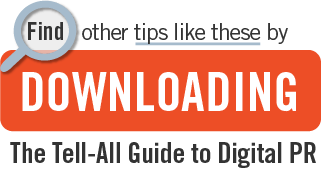
There is a lot that goes into crafting the perfect pitch email, from the necessary beforehand research to the length of your message.
But you can’t afford to miss any opportunity to make your pitch stand out.
To ensure you’re covering your bases, here’s a pitch email checklist to review before you click “send.”
Is your subject line engaging?
If they don’t open your email, you didn’t even earn yourself the chance to make your pitch.
For this reason, do not underestimate the importance of a well-thought-out subject line.
One quick way to test eye-catching effectiveness? Send different subject-line emails to yourself to see what stands out. This strategy will help you identify too-long text phrases that may get cut off in an inbox.
If you need help coming up with good subject lines, here’s a breakdown of the different types that work.
- Statistic-based: Calls out an engaging statistic from the data. These are one of the most successful types of subject lines.
Example: 76% of India’s STD-Related Questions on Yahoo Are Based on AIDS & HIV
- Content title: Using the content’s title is the most straightforward approach but only attempt it if you can think of a title that’s inherently interesting.
Example: 19,558 Yahoo Questions Relate to STDs [Data Visualization]
- Information gap: Based on the “information gap theory of curiosity,” this type is effective because of the innate human behavior that’s triggered when people discover a gap between what they know and what they want to know; this gap prompts people to take action (i.e., open your email).
Example: Which Countries Ask the Most STD-Related Questions on Yahoo Answers?
- Personalized: This type is entirely based on personal information you discovered about the writer via his or her digital footprint, and it helps you to stand out. Only use this for high-tier publications that may overlook other types of headlines.
Once you’ve written a few subject lines, test out the ones you think are most engaging. If they’re not getting a high response rate, move on to the next.
Is your email as short as it can be while still being effective?
When writing a pitch, you must say a lot without using too many words. No writer or editor has time to read a novella-length pitch, so make sure to keep things concise.
In fact, according to an exclusive survey we did of 1,300 publishers, about half of the respondents said they preferred emails between 100 and 200 words long.
If your email is longer than that, re-read it and ask yourself: Is there anything here the writer doesn’t need to know or that doesn’t generate genuine interest in the content?
Despite needing to keep things short and sweet, remember that the email must have the following:
Keep each section straightforward, and you should be set lengthwise.
Does your pitch tell a story?
People aren’t interested in data points and studies unless they’re part of a greater story. Don’t make the writer or editor dig around your project to figure out what the point is – tell him or her what your content is really about.
When reviewing your project, ask yourself these questions, and be sure to communicate the answers in your pitch email in some way.
- What is the story here?
- Always tie this into a newsworthy element, like taking a local angle or pointing out a recent event that makes your content timely.
- Why would people be interested in this?
- Call out the most compelling insights from the content in a bullet list, so they’re easy to find in the email and understand.
- What are the emotions present, and why?
- To identify those elements, take a look at the content like you’re an everyday reader. What strikes you? What surprises you? What catches your attention most?
If you can successfully incorporate the answers to these questions in your pitch, you have a much better chance of securing the writer’s or editor’s interest.
Does your pitch include an appropriate call to action at the end?
Once you’ve written a compelling email, don’t forget about directly asking a question about whether they’re interested in publishing the content.
An example of how it should be phrased is, “Are you interested in writing about this story for your readers?”
However, one important thing to consider is whether you’re offering the content exclusively, meaning that writer would get the benefit of being the very first to cover the story you’re giving them.
If so, this must be included in your call to action because it serves as an important reminder of two things:
These two reminders will increase the chances of getting a response in a timely manner.
Reviewing this entire checklist before clicking send — as well as using tools like this free one from Campaign Monitor — will work as a great quality check and help you feel confident you’ve done everything you can to craft an effective pitch.
But don’t forget the importance of also checking for technical things like grammar and spelling. Always double-check that you have the email address typed correctly as well as the recipient’s name. Silly mistakes like these can cost you an amazing media mention.








